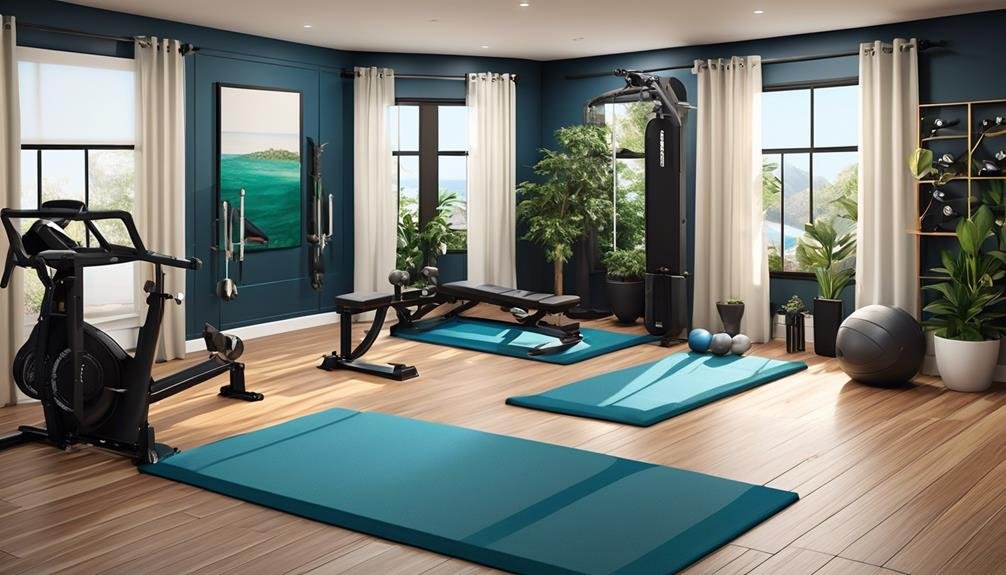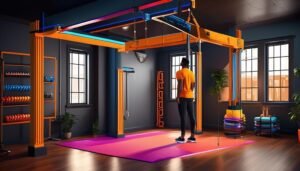When you're in your home gym, it's your sanctuary, a place where you can find solace and focus on your fitness goals.
But it's important to remember that what happens in your gym doesn't stay confined within those walls. The last thing you want is to disturb your neighbors with the clanging of weights or the thumping of your workout routine.
So, how can you create a soundproof haven that keeps the peace and allows you to push your limits without worry?
Well, you're about to discover some practical tips and techniques that will help you achieve just that. From strategic location choices to innovative soundproofing solutions, you'll soon have a gym that not only keeps the noise inside but also gives you the freedom to train without restraint.
Key Takeaways
- Choose a gym location away from communal living spaces or bedrooms to minimize noise disturbance.
- Use insulation, sound-deadening drywall, and acoustic panels to reduce noise transmission and absorb sound vibrations.
- Opt for rubber mats or flooring to absorb sound and minimize vibrations, especially for weightlifting activities.
- Invest in quieter equipment options and use sound-absorbing materials such as acoustic panels and rubber mats to create a more harmonious and focused workout environment while reducing the chances of receiving noise complaints.
Location Considerations for Soundproofing
When considering the soundproofing of your home gym, it's crucial to carefully choose its location to minimize noise disturbance in other areas of your house. The location considerations for soundproofing your home gym are essential to create a peaceful workout environment without disturbing your neighbors or other family members. To reduce noise transmission, it's recommended to place your gym away from communal living spaces or bedrooms. By doing so, you can minimize the impact of gym sounds on adjacent rooms or sleeping areas.
Another effective solution is to alter your workout routine, focusing on exercises that produce less noise.
To further soundproof your home gym, insulation is key. Insulating your gym space not only reduces noise but also improves climate control. By taking measures to deaden sound and prevent it from escaping your gym, you can create a quieter space for your workouts. Using rubber mats or flooring is another effective way to reduce noise and vibrations. These materials absorb sound and minimize the impact of your movements on the floor.
Lastly, it's essential to seal any cracks and gaps in your gym space. This prevents sound leakage and ensures that the soundproofing measures are effective. By carefully considering the location of your home gym and implementing these soundproofing techniques, you can create a quiet and enjoyable workout environment while minimizing noise disturbance in your home.
Building Quiet Walls and Insulation
To effectively soundproof your home gym, one crucial step is to focus on building quiet walls and implementing insulation techniques. Sound-deadening drywall can be installed to limit sound transmission. This specialized drywall is designed to reduce noise and prevent it from escaping the gym, helping to minimize disturbances to your neighbors.
Additionally, using insulation behind the drywall further reduces noise by absorbing sound vibrations. Insulation acts as a barrier, preventing sound waves from traveling through the walls and into adjacent spaces.
Hanging acoustic panels in the gym can also help absorb sound and reduce noise. These panels are specifically designed to improve acoustics by absorbing sound waves, preventing them from bouncing off the walls and creating echoes.
When building the walls for your home gym, consider constructing them thicker than standard walls and using soundproofing insulation. Thicker walls provide an additional layer of sound insulation, while soundproofing insulation helps to minimize sound transmission.
Flooring Options for Noise Reduction
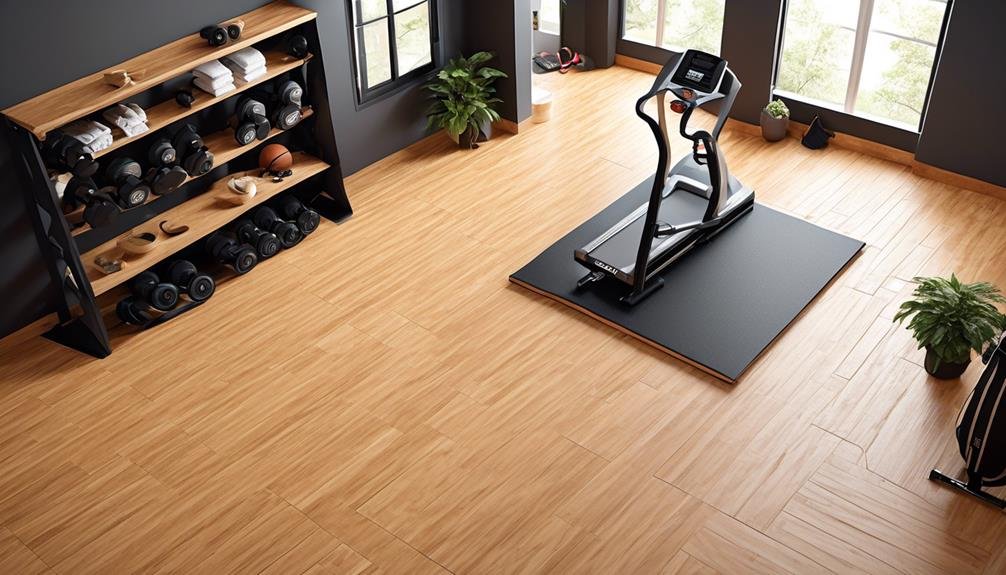
Consider using rubber mats or specialized sound-dampening flooring to effectively reduce noise and absorb vibrations in your home gym.
When it comes to soundproofing your home gym and minimizing noise that may disturb your neighbors, choosing the right flooring is crucial. Rubber mats are a popular choice due to their sound absorption properties and ability to dampen vibrations. Opt for thicker rubber flooring, at least 8 mm or 5/16 inch, for general use, and consider 3/8 or 1/2 inch thick rubber flooring for activities like Olympic lifting, powerlifting, or CrossFit workouts, which involve heavier weights and more impact.
In addition to rubber mats, there are also specialized sound-dampening flooring options available for home gyms and weightlifting areas. These flooring options are specifically designed to minimize noise and vibrations, ensuring a quieter workout environment. Look for extra thick floor tiles, around 30 mm or 1.18 inches thick, or consider 2.5 inch thick rubber tiles from companies like Eleiko for affordable noise-canceling options. These thicker flooring options provide superior sound absorption and help to reduce noise transmission.
Another option to consider is using a soundproof underlayment beneath your rubber flooring. This additional layer can further enhance the noise reduction capabilities of your home gym flooring. It acts as a barrier, absorbing sound and preventing it from traveling through the floor and disturbing your neighbors. When selecting an underlayment, look for one that's specifically designed for soundproofing purposes.
Using Acoustic Panels and Curtains
For effective soundproofing in your home gym, incorporate acoustic panels and curtains into your design. Acoustic panels are an essential component of soundproofing measures as they absorb sound waves, significantly reducing noise transmission. These panels are made from sound-absorbing materials such as foam or fiberglass, and their installation on the walls and ceiling of your gym can help absorb and dampen the noise generated during your workouts.
When selecting acoustic panels for your home gym, look for those that have a high Noise Reduction Coefficient (NRC) rating. This rating indicates the panel's ability to absorb sound waves and reduce the noise level in the space. Additionally, consider installing wall panels with soundproofing insulation to further enhance the soundproofing capabilities of your gym.
In addition to acoustic panels, using curtains can also contribute to soundproofing your home gym. Heavy-duty curtains made from sound-absorbing materials can help block and absorb impact noise, such as the sound of weights being dropped or equipment being moved. These curtains can be installed on the walls or windows of your gym to further reduce the amount of noise that escapes the room.
To maximize the effectiveness of your soundproofing measures, consider combining the use of acoustic panels and curtains with other flooring options such as rubber mats or rubber matting. These materials can help absorb impact noise and vibrations, significantly reducing the amount of noise that reaches your neighbors' ears.
Soundproofing Doors and Windows
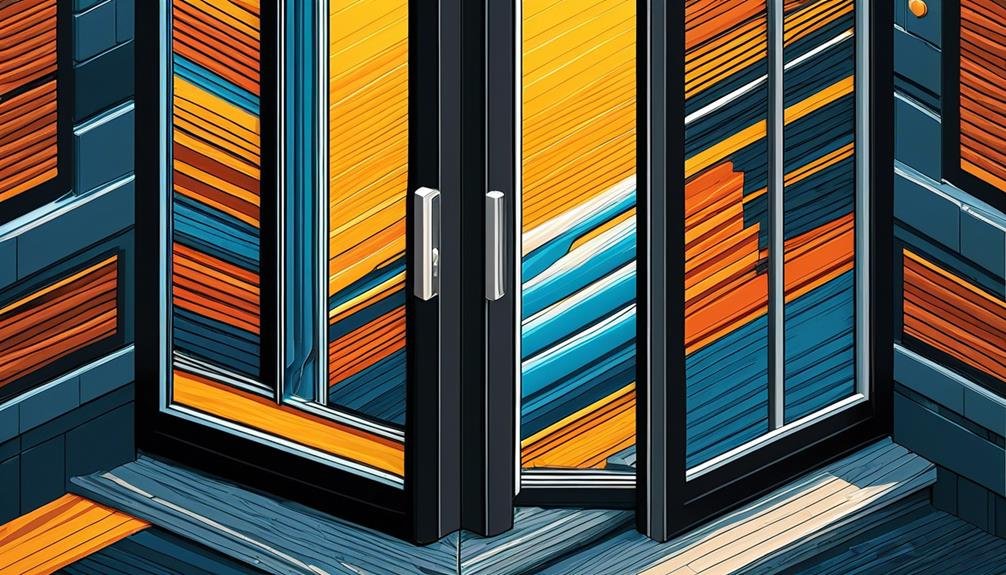
Minimize noise leakage and create a more disciplined and focused workout environment by soundproofing the doors and windows of your home gym. Here are three soundproofing tips to help you achieve a quieter workout space:
- Install weatherstripping around doors and windows: This simple yet effective technique helps to seal any gaps and prevent noise from entering or escaping your workout area. Choose high-quality weatherstripping materials that are dense and durable for maximum soundproofing.
- Use acoustic panels or soundproofing foam on windows: These materials are designed to absorb sound waves and reduce noise transmission. Install them on your windows to create a barrier that prevents sound from entering or leaving your home gym. Look for panels or foam specifically designed for soundproofing to ensure optimal results.
- Install soundproof door covers: These covers are specially designed to block out noise and create a more focused workout environment. They're typically made of dense materials that effectively reduce sound transmission. Install them on your gym doors to minimize noise leakage and create a quieter space for your workouts.
Quieter Equipment Choices
To further enhance the soundproofing of your home gym, explore quieter equipment choices that will minimize noise and provide a more focused workout environment.
One option to consider is using rubber bumper plates. These plates not only decrease noise but also protect your gym floor from damage.
Another choice for quieter cardio workouts is to opt for skipping ropes, regular stationary bikes, or direct-drive indoor trainers. These options produce less noise compared to other cardio equipment such as treadmills or ellipticals.
Additionally, investing in a high-quality sound system like Sonos One Gen speakers can help reduce gym noise by providing clear and immersive audio for your workout sessions.
When it comes to weights, choosing rubber-coated dumbbells and kettlebells can minimize the clanging sounds that traditional metal weights can make.
Lastly, resistance bands are a quiet alternative to traditional weights and can provide a challenging workout without the noise.
Implementing Sound-Absorbing Materials
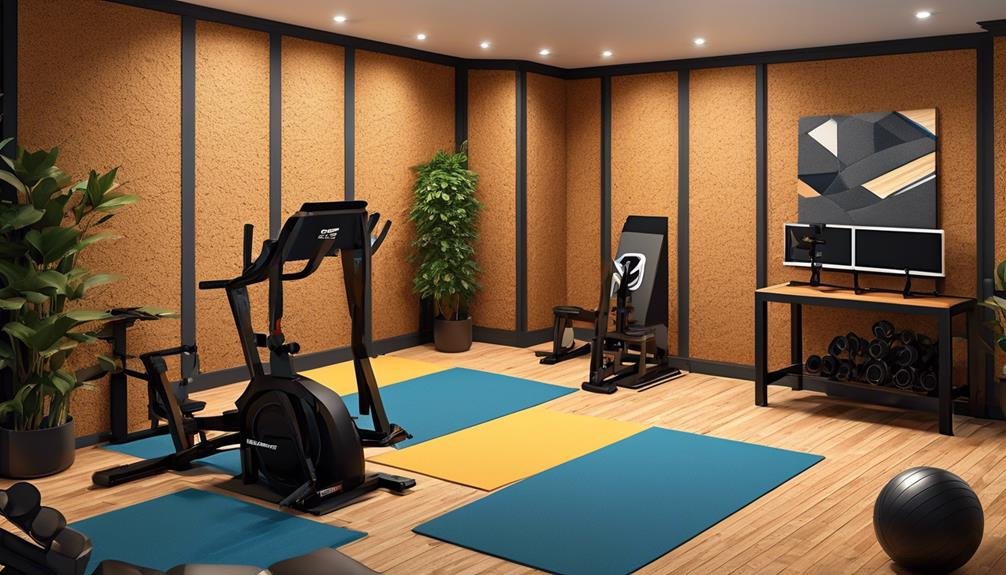
Consider incorporating sound-absorbing materials into your home gym to create a quieter and more focused workout environment. By implementing these materials, you can reduce noise transmission and minimize the chances of receiving noise complaints from your neighbors.
Here are three essential sound-absorbing materials that you should consider integrating into your home gym:
- Acoustic Panels: Install acoustic panels on the walls and doors of your gym to absorb and reduce sound within the space. These panels are designed to trap and dampen sound waves, providing a more acoustically controlled environment for your workouts.
- Rubber Mats: Use thick rubber flooring or mats to dampen vibrations and decrease sound, especially for weightlifting activities. Rubber mats act as a barrier that absorbs impact and reduces noise when weights are dropped, ensuring a quieter workout experience.
- Mass-Loaded Vinyl and Additional Drywall: Consider adding mass and density to the walls by using materials like mass-loaded vinyl, green glue, or additional layers of drywall. These materials help prevent sound transmission, ensuring that your workouts don't disturb others.
Additional Tips for Minimizing Noise in the Home Gym
To further reduce noise in your home gym, there are additional tips you can implement for a quieter and more enjoyable workout experience.
One effective method is to install acoustic panels on the walls of your gym. These panels are designed to absorb vibrations and block out noise, helping to reduce the overall noise levels in the room.
Another option is to place rubber mats on the floor of your home gym. These mats not only protect your flooring from the impact of weights but also help to absorb vibrations and reduce noise.
Additionally, consider using rubber or urethane coated weight plates instead of traditional metal plates. These coated plates minimize noise disturbance when they come into contact with each other or the floor.
If you're looking for quieter alternatives for your workouts, you may want to consider using sandbags or sand bells instead of traditional weights. These items produce less noise when dropped or moved, creating a more harmonious living environment for you and your neighbors.
Frequently Asked Questions
How Do You Soundproof a Gym?
To soundproof a gym, you can start by considering the gym's location and schedule. Choose quieter workout routines, invest in bumper plates, use cloth tape for dampening, and consider a lifting platform.
How Do I Soundproof so I Don't Hear My Neighbors?
To soundproof and minimize noise from your home gym, consider location, quieter workout routines, bumper plates, cloth tape for dampening, and a lifting platform. These measures will help reduce disturbances to your neighbors.
How Do I Soundproof My Garage Gym?
Consider the impact of your gym on adjacent rooms or sleeping areas. Opt for quieter exercises like bodyweight workouts or using coated dumbbells. Invest in bumper plates and apply cloth tape to dampen noise.
What Is the Best Soundproofing for Noisy Neighbors?
To soundproof your home gym and minimize disturbance to neighbors, consider using acoustic panels, soundproofing drywall, insulation, and vibration isolation pads. These materials help absorb and dampen noise, creating a quieter environment for your workouts.
Conclusion
In conclusion, by implementing the soundproofing measures discussed in this article, you can effectively minimize noise in your home gym and prevent disturbing your neighbors.
Consider the location of your gym, invest in noise-reducing equipment, and use sound-deadening materials, insulation, and acoustic panels.
By taking these steps, you can create a quieter workout space and ensure a peaceful environment for yourself and your neighbors.


